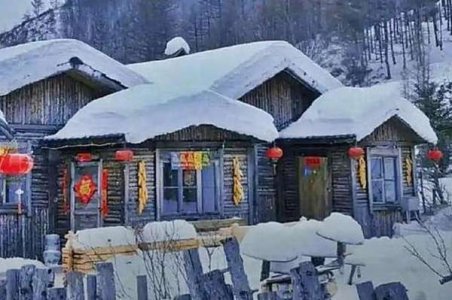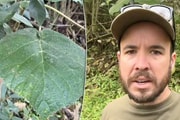Why this snow-covered attraction has everyone talking? It's not for the right reasons!
By
Maan
- Replies 1
Tourist attractions often go to great lengths to create picture-perfect experiences, but sometimes, reality falls short of expectations.
One destination in southwestern China promised visitors a magical winter wonderland, complete with snow-covered landscapes.
However, what guests discovered upon arrival sparked outrage and an official investigation.
A tourist attraction in southwestern China faced backlash after visitors expecting a winter wonderland discovered that the ‘snow’ was actually cotton wool and foamy water.
The Chengdu Snow Village in Sichuan province had promoted itself with images of cabins covered in thick layers of snow, drawing in visitors during the Lunar New Year holiday.
However, those who arrived at the site were met with large sheets of cotton scattered across the area, leaving many frustrated and disappointed.
Images shared on social media showed cotton draped over a field, tangled in bushes, and even stapled onto rooftops.
One structure had what looked like bedding material spread across its roof, with visible staple marks confirming the illusion.
Watch the video below.
In response to the controversy, the Snow Village issued an apology, attributing the situation to unusually warm weather.
‘In order to create a “snowy” atmosphere the tourist village purchased cotton for the snow... but it did not achieve the expected effect, leaving a very bad impression on tourists who came to visit,’ the statement read.
The attraction promised refunds to visitors who were unhappy with their experience.
A staff member told the media that the plan had been to use the location for photo opportunities while waiting for natural snowfall.
‘Following the precedents of previous years, we typically have snow in winter. So we set up this spot for photoshoot in advance to wait for the snow to come.’
‘However, this year, the weather didn’t cooperate, and it didn’t snow.’
The attraction later removed all promotional images from its official social media accounts.
Chengdu’s culture and tourism bureau confirmed that the village had shut down and was under investigation for potential false advertising.
The controversy highlighted a growing issue faced by tourist spots that rely on snowfall, as global temperatures continue to rise.
China recorded its warmest year on record in 2023, with Chengdu’s January temperatures typically ranging between 3°C and 10°C.
Even major events like the 2022 Winter Olympics in Beijing had to depend almost entirely on artificial snow due to inconsistent winter conditions.
This was not the first time a Chinese tourist attraction had come under scrutiny for misleading visitors.
In 2023, a viral video exposed that a supposedly natural waterfall in Henan province had been artificially enhanced with a water pipe.
Park officials later admitted that the waterfall had undergone ‘a tiny improvement during dry season’ to maintain its appeal.
That same year, a zoo in China was also caught in a scandal after revealing that its ‘pandas’ were actually painted dogs.
Watch the video below.

With so much effort put into creating a magical winter experience, do you think this attraction went too far with its snow substitute? Share your thoughts in the comments!
One destination in southwestern China promised visitors a magical winter wonderland, complete with snow-covered landscapes.
However, what guests discovered upon arrival sparked outrage and an official investigation.
A tourist attraction in southwestern China faced backlash after visitors expecting a winter wonderland discovered that the ‘snow’ was actually cotton wool and foamy water.
The Chengdu Snow Village in Sichuan province had promoted itself with images of cabins covered in thick layers of snow, drawing in visitors during the Lunar New Year holiday.
However, those who arrived at the site were met with large sheets of cotton scattered across the area, leaving many frustrated and disappointed.
Images shared on social media showed cotton draped over a field, tangled in bushes, and even stapled onto rooftops.
One structure had what looked like bedding material spread across its roof, with visible staple marks confirming the illusion.
Watch the video below.
In response to the controversy, the Snow Village issued an apology, attributing the situation to unusually warm weather.
‘In order to create a “snowy” atmosphere the tourist village purchased cotton for the snow... but it did not achieve the expected effect, leaving a very bad impression on tourists who came to visit,’ the statement read.
The attraction promised refunds to visitors who were unhappy with their experience.
A staff member told the media that the plan had been to use the location for photo opportunities while waiting for natural snowfall.
‘Following the precedents of previous years, we typically have snow in winter. So we set up this spot for photoshoot in advance to wait for the snow to come.’
‘However, this year, the weather didn’t cooperate, and it didn’t snow.’
The attraction later removed all promotional images from its official social media accounts.
Chengdu’s culture and tourism bureau confirmed that the village had shut down and was under investigation for potential false advertising.
The controversy highlighted a growing issue faced by tourist spots that rely on snowfall, as global temperatures continue to rise.
China recorded its warmest year on record in 2023, with Chengdu’s January temperatures typically ranging between 3°C and 10°C.
Even major events like the 2022 Winter Olympics in Beijing had to depend almost entirely on artificial snow due to inconsistent winter conditions.
This was not the first time a Chinese tourist attraction had come under scrutiny for misleading visitors.
In 2023, a viral video exposed that a supposedly natural waterfall in Henan province had been artificially enhanced with a water pipe.
Park officials later admitted that the waterfall had undergone ‘a tiny improvement during dry season’ to maintain its appeal.
That same year, a zoo in China was also caught in a scandal after revealing that its ‘pandas’ were actually painted dogs.
Watch the video below.
Key Takeaways
- Chengdu Snow Village in China faced backlash after visitors discovered the 'snow' was cotton wool and foam, not real snow.
- The attraction blamed warm weather and offered refunds, removing promotional content from social media.
- Authorities are investigating the village for false advertising amid growing concerns over snow-dependent attractions.
- Similar scandals have occurred in China, including fake waterfalls and misrepresented animals.
With so much effort put into creating a magical winter experience, do you think this attraction went too far with its snow substitute? Share your thoughts in the comments!
Last edited:








